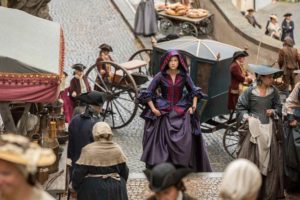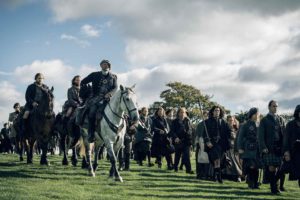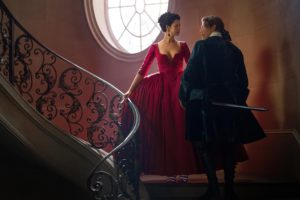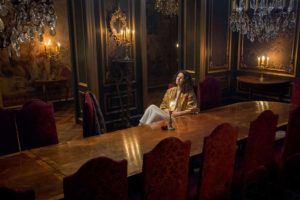
Outlander follows the story of WWII combat nurse, Claire Randall (Caitriona Balfe), swept back in time to 1743 and an unknown world where a passionate relationship with a chivalrous Scottish warrior (Sam Heughan) ensues.
Because of the city’s historic architecture, it might seem that re-creating two time periods for Outlander on location in Glasgow, Scotland would be easy for production designer Jon Gary Steele. Not so. The company must take down telephone poles when they can get permission, remove lamp posts all the time, as well as fences, water coolers, air conditioners, anything that should not be seen.
“Even though the shell, the exterior is 18th century, almost every location has tons of stuff that has to be taken away, covered up. The windows are always wrong because they’re this century. Almost every window and door is changed via the art department, or if it is up high, it’s CGI, visual effects,” explained Steele.

With Outlander being Steele’s first major period piece, even he was shocked with how much work the greensmen did. Two weeks were spent on every exterior, covering with greenery everything that could not be removed that was not authentic to the period.
“Even in the gardens, we laid down something like astro-turf when we shot at Drummond Castle, because the shoes would be sinking into the damp soil. The shoes are very expensive, so we bought a huge amount of this turf. We aged it down since it was a little bright,” shared Steele. “We do things like that all the time and you would never know.”
Although complete sets were not built, almost every location needed extensive work, from plugs, to walls of stone, to extensions. Adding to the design difficulties, locations are constantly changing since the production moved to different areas in support of the story. Nevertheless, Steele stated, “Between construction, art department, set decoration, greens, the team of magicians comes in and turns it into whatever it needs to be.”

The choice of colors was coordinated with costume designer, Terry Dresbach. Having collaborated with Steele for almost thirty years, she revealed, “Gary and I see with the same eyes. That is how we became close friends. It was an instant connection over color and design… He is like my twin brother.”
The first season’s color palette was generally subdued, with grey stone and brown wood common to the era. Red was not used except for the British redcoats and Claire’s red dress, which allowed the costumes to pop out from the background. Season two colors were pumped up to support the opulence of the French court with the use of deep, rich gold highlights on all buildings, and even wine colors. In both the 1940’s and 1740’s sequences, white was avoided or painted over with grey.
Collaboration with actors in developing character through wardrobe was critical for the costume designer, but according to Dresbach it is usually be more difficult getting modern actors into a recent period such as the 1980’s than 18th century clothing.
“Dress from hundreds of years ago is so foreign that everyone throws their preconceived notions about costumes out the window,” noted Dresbach. “The artistic process is about collaboration. At some point it all has to work together. It has to work with the production design; it has to work with the story; and the actors have to be able to wear it and feel they are who they are supposed to be. I always say that I don’t create clothes. I create characters.”

The process is the same in both a contemporary and period piece. Dresbach affirmed, “There is a point in the fitting when the actor starts to move differently, to really embody their character and become something physically different in front of your eyes. It’s the most amazing moment in my process that I live for where an actor organically finds their character through the costume.”
The biggest challenge Dresbach faced on Outlander was scale. At the beginning of season one, she thought she would be able to rent the majority of the wardrobe, but after checking out the costume houses, she realized her department would have to make a staggering number of costumes. To dress massive battle scenes, whole villages and the French court required thousands of costumes. Ultimately they built the entire show – ten thousand garments that included everything from petticoats to gloves, hats, and shoes – and because 18th century textiles are not available, Dresbach’s team had to make the fabric as well using modern techniques.
“We make half a movie every episode,” Dresbach disclosed. “I remember reading that on The Last Emperor they dressed 25,000 people and that seemed so staggering to me, although by the time I’m done with Outlander, I will probably have dressed 100,000 people.”





